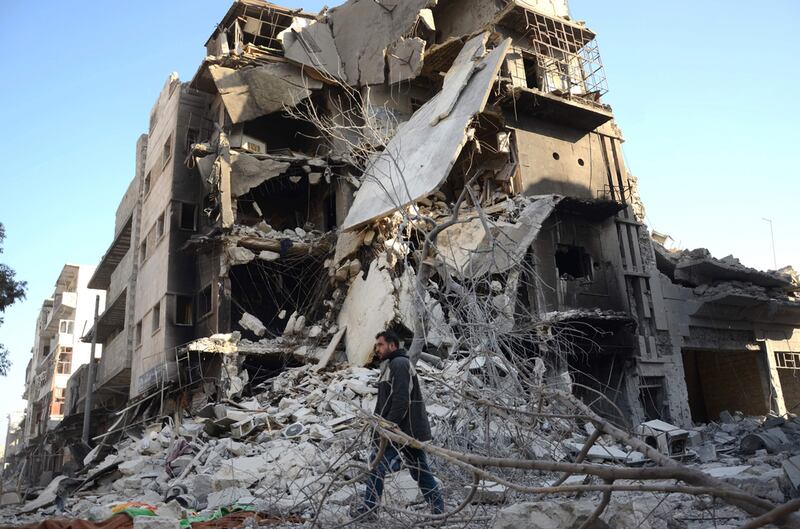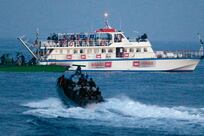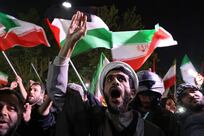On Saturday, Al Qaeda in Syria killed a high-profile intelligence chief in central Syria. The meticulously executed operation is a reminder that it was such tactics that gave prominence to Al Qaeda in 2012, and the organisation might refocus on such operations to build legitimacy as the rebels continue to lose territory.
The operation was conducted in two neighbourhoods in the city of Homs, and targeted the security and military intelligence complexes. One group of militants reportedly entered the military intelligence complex and shot Maj Gen Hassan Daabul, who headed the security branch in Homs exactly a year ago.
Around 40 officers and security personnel were killed in the twin attacks, which were carried out by five militants. Brig Gen Ibrahim Darwish, who heads the other attacked branch, reportedly survived with injuries.
Maj Gen Daabul was appointed the military intelligence chief in Homs precisely to restore peace in the city, which was recaptured by the regime in 2014. He famously pledged before residents that he would put an end to suicide attacks there. That militants were able to infiltrate the city, enter the facility and shoot him will deepen distrust in the regime’s ability to protect such strongholds where it has demographic and territorial depth. In several attacks carried out in May last year by five ISIL militants, 184 were killed in the regime’s heartlands in Tartus and Latakia.
His death adds to the internal troubles of the regime and bolsters Al Qaeda’s standing in the country. The attack was a move by Al Qaeda to regain control of public opinion in rebel-held areas a month after clashes erupted between it and the rebels in north-western Syria.
The group – now known as Hayat Tahrir Al Sham, previously known as Jabhat Fateh Al Sham and before that Jabhat Al Nusra – had launched a consolidation campaign in Idlib against various rebel factions it accused of conspiring with foreign countries against it.
The clashes, initiated by the group, turned public opinion against a jihadist organisation that mostly focused on fighting the regime of Bashar Al Assad. Despite the risks of clashing, though, the group knew the limits of public animosity to it. The group largely achieved its goal of weakening its rivals and further entrenching itself in Idlib and adjacent areas. One operation against the regime was enough to put an end to the high tensions.
Before he moved to Homs, Maj Gen Daabul was in charge of “the branch of death”, a reference to the notorious branch 215. The branch is now notorious as the site of mass death and torture of thousands of prisoners as shown by more than 50,000 photographs released by a government defector identified as Caesar. During his work in the “branch of death”, he also oversaw death squads in the Damascus suburbs and led the vicious campaign to expel the rebels from Daraya. So, his demise is good news for many in Syria and beyond.
Also, his death is not an isolated incident. An official at the Hmeimim airbase in Latakia said the operation was an example of a trend.
“Terrorist attacks that target specific security, military and government officials are increasing in a noticeable way,” read a statement posted on the Russian airbase’s official Arabic page. “The attack in Homs was executed professionally and with full knowledge on the part of the assailants of the details of the building they attacked.”
Last week, the same military mission also announced the killing of four Russian personnel by a roadside bomb near Palmyra, in Homs. Curiously, it highlighted that the road was “continuously monitored by friendly ground forces” – a tacit finger-pointing to the pro-government forces there.
The sophisticated method of the attack is reminiscent of Al Qaeda’s early attacks against the regime. Al Qaeda initially focused on targeting what its leader in Syria called the pillars of the regime, namely officials and security and army compounds. Attacks included the storming of the army headquarters in central Damascus in September 2012. Subsequently, the group operated as other insurgent groups focusing on fighting to expel the regime and seize areas.
The group might revert to the old tactic as the regime expands its territory. While it focused on battling the regime on the front lines, the group seems to have improved the tactic significantly.
Rather than sending a suicide bomber, the group seems to have employed the tactic as part of a maximalist hit-and-run tactic. This is a tactic that ISIL has perfected over the years, and Al Qaeda might make it even more deadly given its infiltration of rebel and regime areas.
In a nutshell, the method and nature of the attack on Saturday shows the limits of the regime’s recent gains from a security perspective.
As the regime turned its attention to the recapture of Aleppo, for example, it lost Palmyra. If such attacks inside regime areas continue, its ability to expand its areas of control beyond its heartlands will be in serious doubt.
This reality should serve as a useful perspective for those counting on a regime victory to stem jihadism in Syria.
Hassan Hassan is a senior fellow at the Tahrir Institute for Middle East Policy and co-author of ISIS: Inside the Army of Terror
On Twitter: @hxhassan





